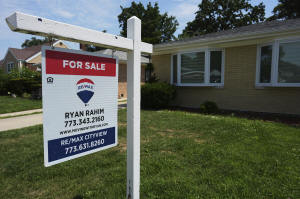Homeowners turn to cash-out refinancing to take advantage of big gains
in home equity
[August 14, 2025] By
ALEX VEIGA
Homeowners are cashing in on years of home equity gains, even as
mortgage rates remain elevated.
The trend sent cash-out home refinancing activity to a nearly three-year
high in the April-June quarter, according to data from home loan data
tracker ICE Mortgage Technology.
In a cash-out refinance, a homeowner takes out a loan for more than they
owe on their mortgage and then pockets the difference. The funds are
often used to consolidate debt, finance home improvement projects and
pay for big-ticket purchases.
The average cash-out refinance in the second quarter resulted in the
homeowner pulling $94,000 in home equity, increasing their monthly
payment by $590. On average, they also raised the interest rate on their
home loan by 1.45 percentage points, according to the report.
To qualify for a cash-out refinance, homeowners must have at least 20%
home equity, have owned the home for at least six months and have at
least a 620 credit score, among other criteria. Borrowers who got a
cash-out refinance in the second quarter had an average credit score of
719, ICE noted.
Years of rising home values have made tapping their home equity a
tempting option for many homeowners. The median price of a previously
occupied U.S. home climbed to an all-time high of $435,500 in June.
That's a 48% increase from just five years ago.
Total homeowner equity in the U.S. hit an all-time high of $17.8
trillion in the second quarter, with $11.6 trillion of available for
homeowners to draw upon by refinancing, ICE said.
All told, cash-out refinances accounted for roughly 60% of all home loan
refis in the second quarter.
A cash-out refinance can give a borrower more financial flexibility,
especially if they can reduce their mortgage rate and use the funds to
lower higher-interest debt. However, the borrower is signing up for a
larger loan, possibly at a higher interest rate than they previously
had, and they're often extending the loan repayment term by several
years.
[to top of second column] |

For Sale sign is displayed in Skokie, Ili., July 24, 2025. (AP
Photo/Nam Y. Huh, File)
That can be risky, because if a
borrower canít pay back the loan, they may not have enough equity
left to avoid foreclosure.
Often, a home equity line of credit, or HELOC, may be a better
option for homeowners, as they generally come with lower interest
rates and the borrower isn't giving up their equity, just borrowing
against it.
Stubbornly high mortgage rates have helped keep the U.S. housing
market in a sales slump since early 2022, when rates started to
climb from the rock-bottom lows they reached during the pandemic.
Home sales sank last year to their lowest level in nearly 30 years.
The market has remained in a slump this year, and while prices have
kept rising nationally, the rate of growth has been slowing or
falling in many metro areas, including Atlanta, Austin and Tampa,
Florida.
The slower pace of home price appreciation, especially for homes in
Sunbelt and Western markets, have led to home equity growth slowing
by its lowest rate in two years, ICE said.
As a result, tappable equity has dropped by at least 5% in nearly
one-quarter of U.S. markets. And about 1% of homeowners with a
mortgage, or roughly 564,000 borrowers, now owe more than their
homes are worth, ICE said.
All contents © copyright 2025 Associated Press. All rights reserved |